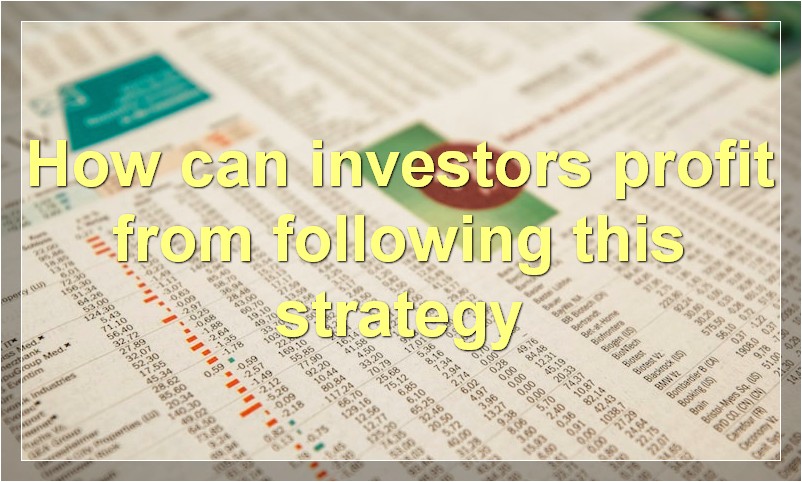Many people believe that “buying the rumor and selling the news” is a profitable investment strategy. However, this strategy comes with risks.
What is the basis for the saying “buy the rumor, sell the news”
There’s an old investing adage that goes, “buy the rumor, sell the news.” In other words, investors tend to buy up stocks when there’s talk of good news on the horizon, driving up prices. Then, when the actual news is announced, they sell off the stock, often at a profit.
Why does this happen? Part of it has to do with human psychology. We’re more likely to act on rumors than on facts. And when it comes to investing, we’re often chasing after the next big thing, even if it’s just a rumor.
But there’s also a practical reason for why this strategy can work. When news is released, everyone knows about it right away. But when a rumor is circulating, only some people know about it. So there’s less competition to buy the stock before the price goes up.
Of course, this strategy isn’t foolproof. If too many people catch wind of the rumor and start buying up shares, the price will go up too much before the news is released. Then you might not be able to sell at a profit. And sometimes, the news doesn’t live up to the hype.
Still, if you’re careful and do your research, buying on rumors can be a profitable strategy. Just remember to sell when the news comes out!
How can investors profit from following this strategy

The answer is simple: buy low, sell high.
Of course, there is more to it than that. But the basic idea is to find stocks that are undervalued by the market and to buy them when they are cheap. Then, when the stock price rises, sell them for a profit.
There are many ways to find undervalued stocks. One way is to look for companies that have strong fundamentals but are trading at low prices. Another way is to look for companies that are out of favor with investors but have sound businesses.
Investors can profit from following this strategy by buying stocks when they are undervalued and selling them when they are overvalued. By doing this, investors can earn profits in both bull and bear markets.
What types of events or announcements typically create profitable opportunities for those who “buy the rumor, sell the news”
There are a few different types of events or announcements that typically create profitable opportunities for those who “buy the rumor, sell the news.” One example might be an upcoming product release from a company. If there are rumors swirling about what the product will be, people may start buying the stock in anticipation of the release. Then, when the product is actually released and the announcement is made, the stock price may go up even further, creating a profit for those who sold at the right time. Another type of event that can create similar opportunities is an earnings report. If there are rumors that a company’s earnings will be better than expected, people may start buying the stock in advance. Then, when the actual report comes out, the stock price may rise even more, creating profits for those who sold at the right time.
What are the risks associated with this strategy
There are a few risks associated with this strategy. First, it is possible that the stock price could drop before you have a chance to sell. Second, if the stock price falls after you buy it, you may not be able to sell it for a profit. Third, you may miss out on opportunities to buy other stocks if you tie up all your money in this one stock.
What other strategies might be used to take advantage of similar situations
There are a few different strategies that can be used to take advantage of similar situations. One strategy is to use social media to your advantage. You can use platforms like Twitter and Facebook to share your blog posts and reach a wider audience. Another strategy is to guest post on other blogs in your niche. This can help you get exposure to new readers and build relationships with other bloggers. Finally, you can participate in online forums and discussions related to your niche. This can help you connect with potential customers and clients, and learn more about your industry.
Is there a downside to “buying the rumor, selling the news”

The market is a forward-looking mechanism. This means that it prices in expected future events. When an event actually occurs, it is generally already priced in, and thus, the market may react differently than what was anticipated. This often happens when there is a discrepancy between the rumor and the news.
For example, let’s say that there is a rumor that Company XYZ is going to be acquired by ABC Corporation. The rumor starts to circulate and the stock price of Company XYZ begins to rise as investors anticipate the potential acquisition. However, when the news is finally announced, the stock price may actually fall because the market has already priced in the expected event. In this case, it would be said that investors “bought the rumor and sold the news.”
There can also be a downside to this scenario if the rumor turns out to be false. In this case, investors may have bought shares of Company XYZ based on false information and could end up losing money if the stock price falls.
Thus, it is important to be aware of rumors circulating in the market and to do your own research before making any investment decisions.
What should investors be aware of when considering this strategy
There are a few things to consider when thinking about investing in penny stocks. For one, it’s important to remember that these stocks are highly volatile and can go up or down very quickly. So, it’s important to have a firm understanding of the risks before investing.
Another thing to keep in mind is that penny stocks are often not well-regulated. This means that there is more opportunity for fraud. Be sure to do your research on any company before investing, and only invest in companies that you trust.
Finally, don’t put all your eggs in one basket. Diversify your portfolio by investing in different types of assets, including penny stocks. This way, you’ll minimize your risk and maximize your chances of making a profit.
Can this strategy be employed successfully in all markets
There is no surefire answer to this question, as different markets may require different strategies for success. However, a few key principles can be applied in any market in order to give businesses the best chance at achieving their goals.
First and foremost, businesses must have a clear understanding of their target market. Without this knowledge, it will be difficult to tailor a strategy that resonates with consumers. Additionally, businesses must be aware of their competition and what they are doing in order to stay ahead of the curve.
Finally, it is important to always be adaptable and willing to change course if necessary. No strategy is perfect, and markets are constantly evolving. By being flexible and open to new ideas, businesses can increase their chances of finding long-term success.
What are some historical examples of successful “buying the rumor, selling the news” trades
There are many historical examples of successful “buying the rumor, selling the news” trades. One well-known example is the so-called “South Sea Bubble” of 1720. In this case, investors bought shares of the South Sea Company based on rumors that the company would be granted a monopoly on trade with Spain’s colonies in South America. When the news finally came out that the company had been granted this monopoly, share prices soared and investors made a killing.
Other examples include the Florida land boom of the 1920s, the dotcom bubble of the late 1990s, and the housing bubble of the early 2000s. In each of these cases, investors bought assets based on speculation that prices would continue to rise. When the news finally came out that prices had reached their peak, investors sold their holdings and made a profit.
So, “buying the rumor and selling the news” can be a highly profitable strategy, but it is also very risky. Investors must be careful not to get caught up in the hype and must be ready to sell when the time is right.
Are there any potential traps that investors need to be aware of when employing this strategy
When employing the strategy of dollar-cost averaging, investors need to be aware of a few potential traps that could occur. The first trap is that investors could end up buying more shares when the price is high and less when the price is low. This could average out the cost per share over time, but it could also lead to sub-optimal results. Another trap is that investors could become too focused on the short-term fluctuations in prices and lose sight of the long-term goal. Finally, investors need to be mindful of fees associated with buying and selling shares, as these can eat into any gains made from using this strategy.

